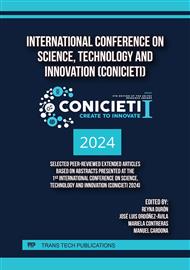[1]
A.K. Tiwari, "Machine Learning Application in Loan Default Prediction". Journal NX - A Multidisciplinary Peer Reviewed Journal, vol. 4, no. 5, pp.1-5, 2018. [Online]. Available: https://repo.journalnx.com/index.php/nx/article/view/(2008)
Google Scholar
[2]
D. M. Obare, G. G. Njoroge, M. M. Muraya, "Analysis of Individual Loan Defaults Using Logit under Supervised Machine Learning Approach". Asian Journal of Probability and Statistics, vol. 3, no. 4, pp.1-12, 2019
DOI: 10.9734/AJPAS/2019/v3i430100
Google Scholar
[3]
A. Lahsasna, R. N. Ainon, T. Y. Wah, "Credit Scoring Models Using Soft Computing Methods: A Survey". The International Arab Journal of Information Technology, vol. 7, no. 2, pp.115-123, 2010. [Online]. Available: https://iajit.org/PDF/vol.7,no.2/712.pdf
Google Scholar
[4]
H. A. Bekhet, S. F. Kamel Eletter, "Credit risk assessment model for Jordanian commercial banks: Neural scoring approach". Review of Development Finance, vol. 4, pp.20-28, 2014
DOI: 10.1016/j.rdf.2014.03.002
Google Scholar
[5]
M. L. Saavedra García, M. J. Saavedra García, "Modelos para medir el riesgo de crédito de la banca". Cuadernos de Administración, vol. 23, no. 40, pp.295-319, (2010)
Google Scholar
[6]
D.M. Obare, M.M. Muraya, "Comparison of Accuracy of Support Vector Machine Model and Logistic Regression Model in Predicting Individual Loan Defaults". American Journal of Applied Mathematics and Statistics, vol.6, no.6, pp.266-271, 2018
Google Scholar
[7]
J. W. do Prado, F. D. Carvalho, G. C. Benedicto, A. L. Lima, "Analysis of credit risk faced by public companies in Brazil, an approach based on discriminant analysis, logistic regression and artificial neural networks". Estudios Gerenciales, vol. 35, no. 153, pp.347-360, 2019
DOI: 10.18046/j.estger.2019.153.3151
Google Scholar
[8]
C.F. Tsai, J.W. Wu, "Using neural network ensembles for bankruptcy prediction and credit scoring". Expert Systems with Applications, vol. 34, pp.2639-2649, 2008
DOI: 10.1016/j.eswa.2007.05.019
Google Scholar
[9]
D. West, "Neural network credit scoring models". Computers & Operations Research, vol. 27, pp.1131-1152, 2000.
DOI: 10.1016/s0305-0548(99)00149-5
Google Scholar
[10]
A. Khashman, "Neural Networks for credit risk evaluation: Investigation of different neural models and learning schemes". Expert Systems with Applications, vol. 37, pp.6233-6239, 2010
DOI: 10.1016/j.eswa.2010.02.101
Google Scholar
[11]
P. Golbayani, D. Wang, I. Florescu, "Application of Deep Neural Networks to assess corporate Credit Rating". arXiv, 2020. [Online]. Available: https://arxiv.org/abs/2003.02334
Google Scholar
[12]
P. Golbayani, I. Florescu, R. Chatterjee, "A comparative study of forecasting Corporate Credit Ratings using Neural Networks, Support Vector Machines, and Decision Trees". arXiv, 2020. [Online]. Available: https://arxiv.org/abs/2007.06617
DOI: 10.1016/j.najef.2020.101251
Google Scholar
[13]
S. Haykin, Neural Networks and Learning Machines, 3rd ed, Pearson, 2009.
Google Scholar
[14]
J. Brownlee, "How to Choose an Activation Function for Deep Learning". Machine Learning. https://machinelearningmastery.com/choose-an-activation-function-for-deep-learning/ (accessed Oct. 5, 2023).
Google Scholar
[15]
T. Babs, "The mathematics of Neural Networks". Medium. https://medium.com/coinmonks/ the-mathematics-of-neural-network-60a112dd3e05 (accessed Oct. 6, 2024).
Google Scholar
[16]
J. Brownlee, "Logistic Regression for Machine Learning". Machine Learning. 2023 https://machinelearningmastery.com/logistic-regression-for-machine-learning (accessed Oct. 5, 2023).
DOI: 10.2174/9789815124422123010005
Google Scholar
[17]
F.E. Salazar Villano, "Cuantificación del riesgo de incumplimiento en créditos de libre inversión: un ejercicio econométrico para una entidad bancaria del municipio de Popayán". Estudios Gerenciales, vol. 29, pp.416-427, 2013.
DOI: 10.1016/j.estger.2013.11.007
Google Scholar
[18]
P. Jiang, J. Zhang, J. Zou, "Credit Card Fraud Detection Using Autoencoder Neural Network". arXiv, 2019. [Online]. Available: https://arxiv.org/abs/1908.11553
Google Scholar
[19]
M. Senoae Santos, J. Pompeu Soares, P. Henriquez Abreu, H. Araújo, J. Santos, "Cross-Validation for Imbalanced Datasets: Avoiding Overoptimistic and Overfitting Approaches". IEEE Computational Inteligence Magazine, vol. 13, no. 4, pp.59-76, 2018
DOI: 10.1109/MCI.2018.2866730
Google Scholar
[20]
D.R. Wilson, T.R. Martínez, "Improved Heterogeneous Distance Functions". Journal of Artificial Intelligence Research, vol. 6, pp.1-34, 1997.
Google Scholar
[21]
F. Aguilar, "SMOTE-NC in ML Categorization Models for Imbalanced Datasets". Medium Analytics Vidhya. https://medium.com/analytics-vidhya/smote-nc-in-ml-categorization-models-for-imbalanced-datasets-8adbdcf08c25 (accessed Oct. 10, 2023).
Google Scholar
[22]
J. Davis, M. Goadrich, "The Relationship Between Precision-Recall and ROC Curves". IEEE Proceedings of the 23rd International Conference on Machine Learning - ICML '06, 2006
DOI: 10.1145/1143844.1143874
Google Scholar
[23]
S. Narkhede, "Understanding Confusion Matrix". Towards Data Science. https://towardsdatascience.com/understanding-confusion-matrix-a9ad42dcfd62 (accessed Oct. 10, 2023).
Google Scholar
[24]
Z. Lipton, C. Elkan, B. Narayanaswamy, "Thresholding Classifiers to Maximize F1 Score". arXiv, 2014. [Online]. Available: https://arxiv.org/abs/1402.1892
Google Scholar
[25]
V. Lendave, "Python Guide to Precision-Recall Tradeoff". Analytics India Magazine. https://analyticsindiamag.com/python-guide-to-precision-recall-tradeoff/ (accessed Oct. 11, 2023).
Google Scholar
[26]
CNBS, "Manual de Reporte de Datos de Crédito". Comisión Nacional de Bancos y Seguros. https://cnbs.gob.hn/wp-content/uploads/2020/02/Ver_2_0_40_MRDC-Capturador-Datos-Credito-SL_NIIF_V_20191209.pdf (accessed Sep. 11, 2023).
Google Scholar



